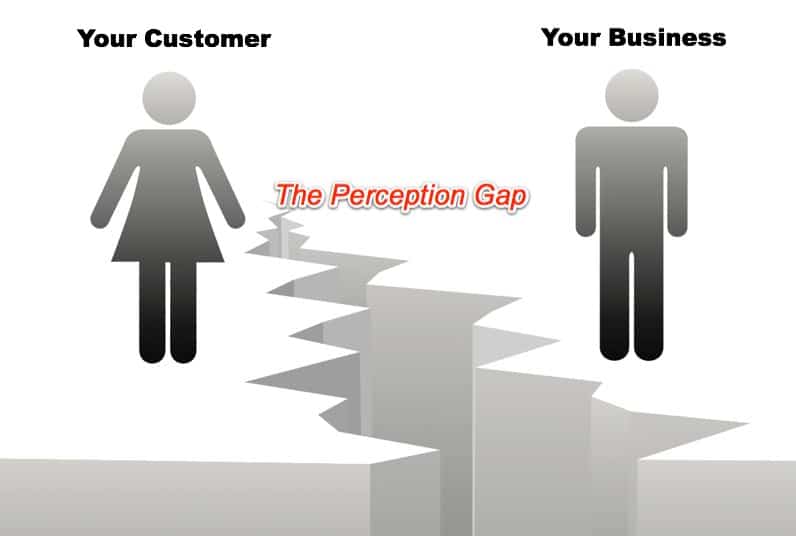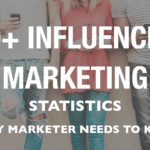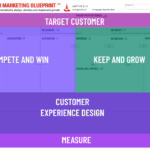Use marketing personas to improve your marketing results. So how many of these “human beings” do you need to create?
If you have too many personas it becomes difficult to manage and keep up, unless of course, you are a big brand. Generally, for any segment, you should have one to three personas to represent your audience.
Table of Contents
What Information Do You Need To Include?
Here is an overview of what you should include in your marketing persona:
There are two types of information, qualitative and quantitative.
The quantitative data covers demographics and market data. Example data below:
Demographics
- Age
- Gender
- Salary/household income
- Location: urban / suburban / rural
- Education
- Family
Demographic tells you who they are.
The other sort of data you need is qualitative. This is data about how customers think, behave, what they like and what they value. Examples are:
- Primary goal (gains)
- Secondary goal
- Goals and challenges in achieving them (pains)
- How you help achieve these goals (gain creators)
- Primary challenge
- Secondary challenge
- How you help solve these problems (pain killers)
- Values / fears
- Lifestyle
- Beliefs
- Motivations
- Behavioural data – what they do
Psychographic segmentation involves understanding your customer’s lifestyle, attitudes, beliefs and values. Why they buy.
Behavioural segmentation (data) shows you how they buy.
What Is A Marketing Persona
Marketing personas are a way of describing real customers who buy, or might buy, the products or services you sell. What’s more, marketing personas are built on information about real buyers who make decisions based on their behaviors and traits.
Why does this matter? First of all, the old-style marketing treats people based on age, income, location, but we are all a bit more three dimensional than that.
In the first place, people don’t just buy on the facts you present them; it isn’t as logical as that. Furthermore, you need to dig deeper and understand what makes people tick. Marketing is about behaviors, feelings, and beliefs.
What does your target audience like or dislike?
How do they spend their time? Marketing personas are an easy way of understanding your customers and prospects and can be used to guide marketing and content decisions.
Why Use A Marketing Persona
Marketing Personas help you understand what influences buying decisions. If you use this information, you can tailor your communications to speak directly to your target customer.
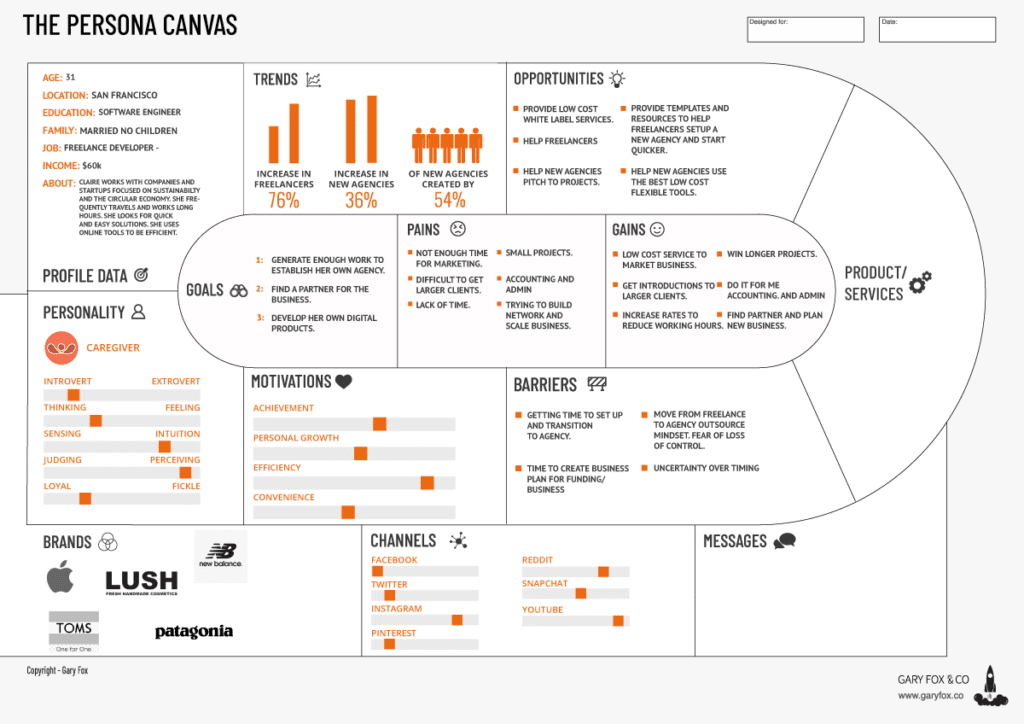
The more you understand your customer the more you will be able to produce content, campaigns and ads that grow your business.
Some of the benefits of using marketing personas are:
- You can match the customer journey and customer decision-making to your marketing.
- Marketing personas simplify decisions on content, campaigns and overall marketing communications.
- Marketing personas help shape marketing messages based on what each marketing persona’s values.
- Teams have a common framework and point of reference to develop marketing campaigns
- Reduces guesswork, speeds up and guides decision making
- Mapping marketing personas to a customer journey map improve conversions see our template below
Marketing personas stop the assumptions. I often find businesses that have no clear customer segmentation and no clear customer profile.
One of the most common problems businesses face is that their customers are changing due to the use of technology, time pressures, the economy, social media..just lots of reasons.
However, often businesses are stuck in their mental model of how the market is structured, who their competition is and who they think is their customer. They often have an outdated or simplified set of ideas about the customer.
Unfortunately, that can be dangerous. If competitors delve deeper into understanding the customer than you and are better and transforming that knowledge into product and services, then inevitably they will steal market share.
Design Thinking Approach
You are probably aware of design thinking and the impact it is having in transforming how we approach not only developing products, but also marketing itself.
Marketing teams have become increasingly fragmented as we have progressively introduced more and more disciplines. We now have data analytics (in some cases big data specialists), social media, content marketing, SEO and of course development teams.
The result is a greater need for shared mental models and new tools to unravel and deal with the complex challenges faced with a large and shifting digital ecosystem that customers participate in.
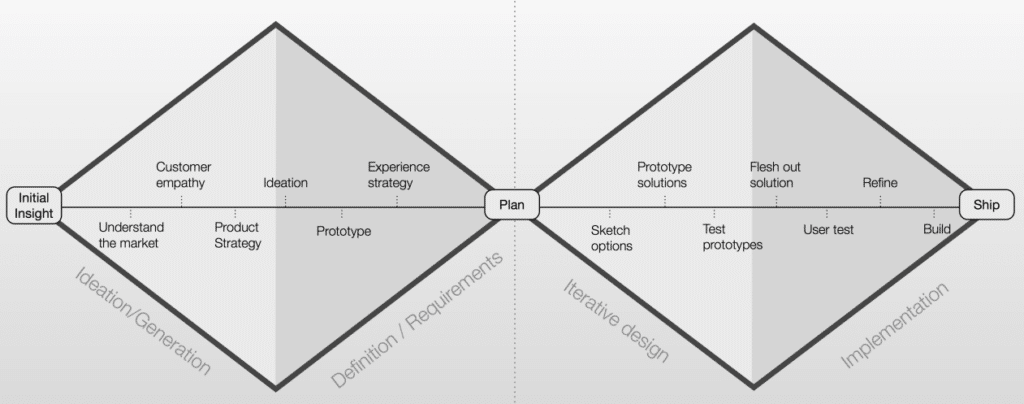
Although Design Thinking has become popular in the realms of new product development, it’s underlying principles and approaches are equally valid for marketing. As you can see from the double diamond the beginning of any approach starts with understanding the market and the customer.
The marketing persona becomes the cornerstone of the progression through the steps. However, unlike a linear system, the design thinking approach reinforces the need to use data and insights gained later in the process to then inform and change the start.
In other words, the marketing persona is not a static representation of the customer but shifts as new data is available.
How To Create A Marketing Persona
Start by downloading a free customer persona canvas.
Developing personas for each of your market segments requires some effort and research, but it does pay off.
Once you have established a clear Marketing Strategy segmenting your customers becomes easier.
Remember to focus on niche marketing rather than compete at a broader marketing level. Create a working set of marketing personas that will work as a framework for your ongoing marketing.
This way you refine and make on your understanding of your customers, and this will strengthen your future marketing activities.
Step 1: Segment Your Customers
Developing your marketing personas should be aligned with how you segment your customers base, e.g. you might sell in different market sectors and so need to build marketing personas based on these sectors.
What Is Market Segmentation?
Market segmentation is the process of dividing a target market into defined categories so that you have groups of customers with similar characteristics. These groups will be based on customers with similar demographics, interests, needs, or location.
How do you segment your customers?
There are in fact four main types of segmentation: demographic, geographic, psychographic and behavioral.
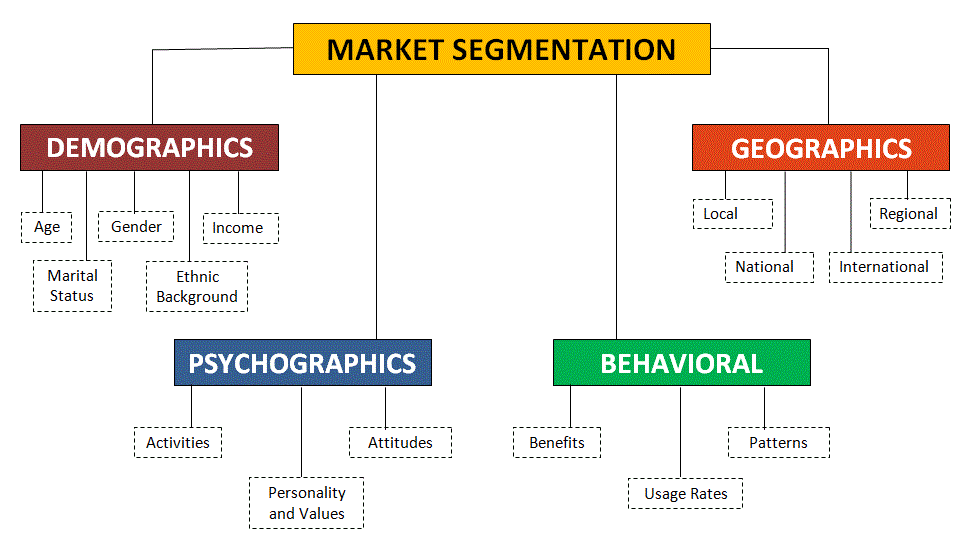
1. Demographic
Demographic segmentation separates your audience by who they are, depending on whether you are in a B2B or a B2C context.
For example, typical business to consumer demographic traits include:
- Age
- Gender
- Occupation
- Income
- Family status
- Education
For business-to-business customers you can use:
- Company size
- Industry type
- Role (within the company)
- Time in position
2. Geographic
Geographic segmentation splits your customers based on where they are located.
For example:
- Continent
- Country
- Region
- City
- Borough/District
Segmenting in this way is useful when a customer’s location affects their purchase decision.
3. Psychographic
Psychographic segmentation separates your customers by what they believe, value and type of personality.
For example:
- Interests
- Attitudes
- Values
- Lifestyle
Some questions that relate to psychographics:
- What are their hobbies?
- Are they outwardly or inwardly focused?
- What passions does the persona follow that isn’t their job?
- What are their life goals?
- What do they do during their free time?
4. Behavioral
Behavioral segmentation divides your customers by their behavior in relation to your brand.
For example:
- Awareness of the business
- Previous purchases
- Purchase patterns
- Usage level
- Product knowledge
- Product/service rating
A key criterion for segmentation is that you can through your channels identify them as a group. What I mean by that is you can reach them according to your segmentation.
Where to find demographic Information
Google Analytics Demographic Data
Inside Google Analytics, use the demographic data. You can filter on this to help you with your marketing personas.
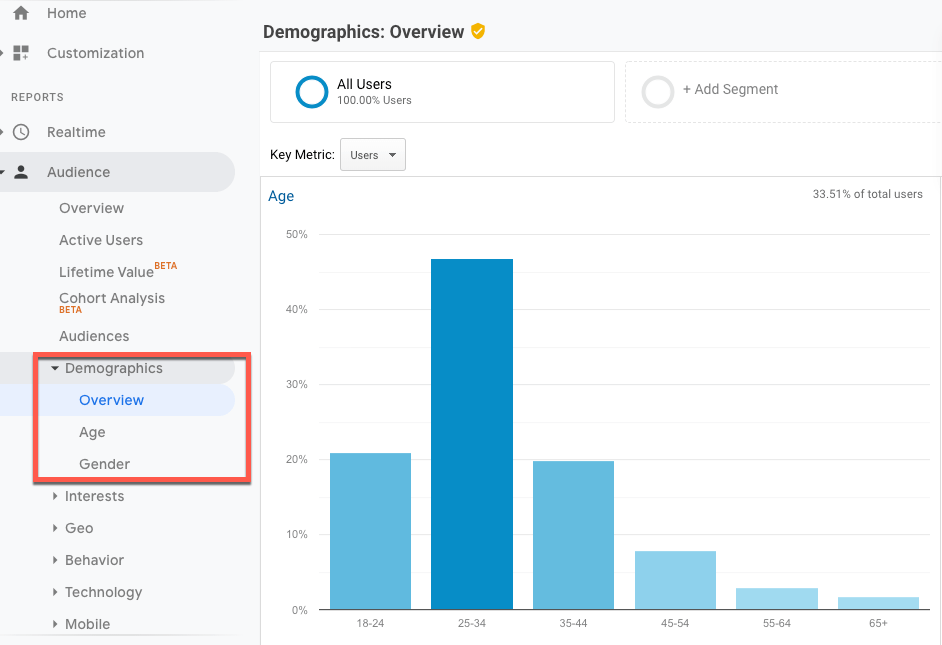
Within Google Analytics you will also find other interests they have as well as where they originated.
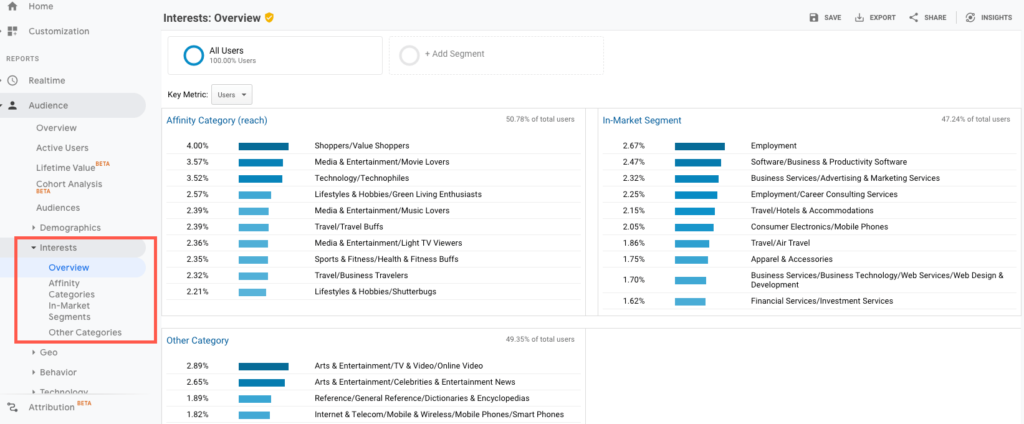
Facebook Page
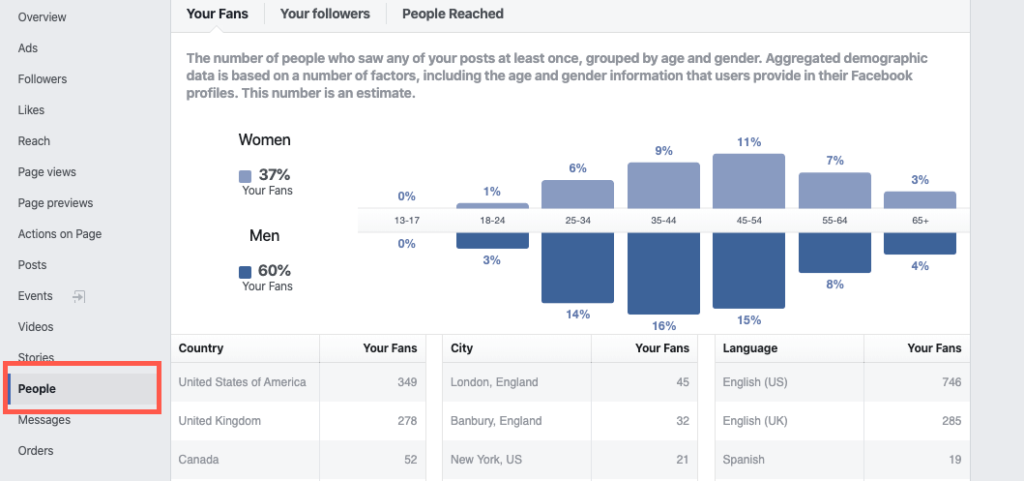
Population Census
Population census is available in most countries. It is conducted at regular intervals, usually every 10 years.
U.S. Government Data
- U.S. Bureau of the Census http://www.census.gov
- U.S. Bureau of Labor Statistics http://stats.bls.gov/blshome.htm
- Current Population Statistics http://www.bls.gov/cps/
- Statistical Abstract of the United States http://www.census.gov/compendia/statab/
- Vital Statistics of the United States http://www.cdc.gov/nchs/products/pubs/pubd/vsus/vsus.htm
International
- World Factbook (CIA) – http://www.odci.gov/cia/publications/factbook/
- Statistics Canada – http://www.statcan.ca
- UN Information Gateway – http://www.library.yale.edu/un/un3b8.htm
- World Bank – http://www.worldbank.org
- Social Science Information Gateway(Southhampton University Library) http://www.sosig.ac.uk/roads/subject-listing/UK/demog.html
- Economic Commission for Latin America and the Caribbean – http://www.eclac.org/index1.html
Step 2: Research Your Customers
Start with what and who you know and build outwards. Whether it is BtoB or BtoC your existing customers hold the key to help you develop your understanding. Build out your profiles based on the information you already know.
Use existing real customers to develop your marketing personas then. Involve your teams and use your internal resources and knowledge – people that know your customers: salespeople, teachers, trainers, customer service team, installers, tech support, etc.
Identify what you know and what information is missing’ Once you have established this you can build your questionnaire and start on face to face interviews.
How to research your customers
Researching customers takes time and perhaps for that reason many people skip it or do the minimum when trying to create their marketing personas.
Research method 1. Online Questions
Quora is a social media platform built just to answer questions. Quora is a where you can type in searches that relate to your business and see what other questions people relate to it. Some of the questions will help you map out how your target customer thinks.
Research method 2. Keyword Research
There are a bunch of keyword research tools that you can use. However, for this type of research, I like to use Ahrefs because they have lots of different ways you can use to filter on keyword results. Furthermore, they offer a section that shows you the questions related to any keyword.
The questions and overall keyword volumes will help you to identify the topics and questions that concern your target customers. See my list of keyword research tools and other SEO Tools.

Research method 3. Online Blogs/Forums and Bulletin Boards
There are lots of useful places to research the questions and answers that relate to your customers. Using bulletin boards, forums and blogs you can pull out key themes about your customer:
- Topics that they are popular
- Divisions and differences on topics that split groups
- Trending topics
- Frequently asked questions
- Frustrations
- Product/Service Reviews
Some useful places to research include:
Research method 4. Interview customers
Radical as this may seem it is your real start point to get insights. When consulting with large multi-national brands, I always look to have at least one hour where I ask questions. Sometimes this is in fact on behalf of a supplier or partner.
To get the most out of these type of interviews follow these 3 simple rules:
- Rule 1: Prepare your questions in advance. Think less rather than more. Remember you want them to talk not you. So allow for them to give lots of information.
- Rule 2: Test them on someone in the business beforehand. In other words, check the phrasing and wording works and gives you a stepped approach to getting more details as you progress.
- Rule 3: do not answer any questions or fill any silence. This is where people fall over when interviewing. They feel awkward if there is a moment of silence and try to fill that by giving examples or unnecessary information. Silence is a powerful tool. Used well you will get answers and more details.
Have a magic question. One of my favorite questions goes like this.
If you could wave a magic wand and do things differently – what would you do?
You can rephrase that to suit you. The point is that it gets customers thinking and imagining different ways of doing things.
Research method 5. Contextual Interviews
Contextual interviews combine observations with interviewing. Although conducting contextual interviews is often time-consuming, if you plan well, you can get a lot of interviews in a short space of time. Essentially a contextual interview involves you watching and listening as users work in their own environment, as opposed to being in a lab. By going to the user, you see the user’s environment and the actual technology the user works with. As a result, contextual interviews are more natural, less formal than lab tests and don’t use tasks or scripts.
Research method 6. Use market reports to identify trends
Professional market reports can give you the macro-level details into what’s happening in your market sector and buyer or consumer trends. Often they can be a useful source for changes in buyer behavior, e.g. how a set of customers are buying behavior is changing as a result of mobile apps.
Some sources of market data:
Research method 7. Surveys
Surveys have had a lot of bad publicity when it comes to understanding customers. However, short surveys can still provide some valuable insights if thoughtfully constructed. As an example, the Net Promoter Score asks one question:
How likely is it that you would recommend this company to a friend or colleague?.
If you put together a very short survey and carefully thought about the questions, you might get a good indication of some useful insights into your customers.
Some tools to use are:
Research method 8. Analyze Your Website and Social Media Data
Social media: where do your customers go online; What social networks do they use, e.g. Facebook, Linkedin, Pinterest…
Review your website data, what content has seen the highest traffic, who has shared your content.
Research method 9. Observation/Ethnography
There is no substitute for observing how customers use your product or service. Often, people answer surveys according to how they think they should. As a result, if you are developing a new product or service you can quickly think that you have the right solution. However, upon launch, you can quickly fail miserably because you never tested an idea in the field.
Observing customers is a well-established way to gain valuable feedback. Observing customers is referred to as ethnography.
Ethnographic research is the qualitative methods used to observe and/or interact with participants in a real-life situation. Although ethnography was originally developed by anthropologists, it has now been accepted and used across disciplines such as marketing. An advantage of using ethnographic research is that it can help identify and uncover unexpected issues.
Often the reason organizations shy way from ethnographic research is cost. Ethnographic studies can take up a lot of time to conduct. Generally, this needn’t be the case but still remains a consideration nonetheless. Generally, ethnographic research is best used in early-stage designs and/or for complex and high-value projects.
Recommendation
As marketers, you want to find the places where your customers engage and interact. As an example, this may be a podcast they listen to or a YouTube channel they subscribe to. There are also influential accounts they follow on Twitter, Facebook, LinkedIn, and Instagram.
However, finding these can be difficult. This is why influencer marketing has grown so rapidly. Take a look at the influencer marketing statistics to see the shift in marketing spend and results.
What you want to know as a marketer:
- is the publications and places where your audience pays attention?
- the content and topics that they respond to.
- the overlap between these and your brand.
Step 3: Create Your Marketing Personas
Marketing personas rely on patterns in the data gathered from the interviews and other sources.
Begin to look for common traits and themes in how people respond, how they buy, the information they look for, what concerns they have, what problems they have, when purchasing, what they value and don’t like.
Use these patterns to group into no more than five marketing personas – too many and it is hard to focus, too few and you are likely to profile people clearly.
Key Action: Keep It, Simple, To Start With – If you make it too complicated people in your business will get lost and not buy-in to using them. Get traction and focus on what will make a difference.
Step 5: Map The Questions and Decisions To A Journey
Use your marketing persona to drive your content. Create great content that speaks to their values, helps them solve problems and matches their style and tone of voice. If you look at our marketing personas template, you will see how you can do this.
By using powerful targeted marketing communication that speaks directly to your target audiences needs, values, interests and needs you can increase your engagement.
People like to know that you understand them. Good marketing communication should speak to your target customer in a way that they know.
By aligning how your customers buy (the Customer Journey Map) with the Marketing Persona you put two powerful marketing methods together. These two marketing methods help you use the right content at each point of the customer buying process.
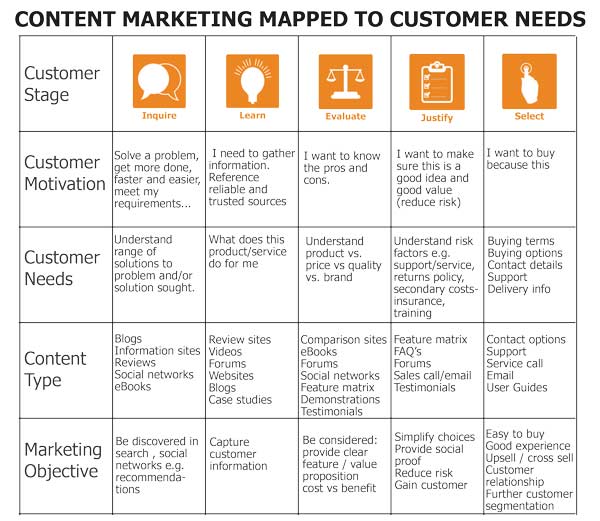
Step 6: Develop The Story and Narrative for your Marketing
Have you noticed how brands use real stories to engage people? We are hard-wired to use stories to help understand the world. Social media creates the digital campfire around which we can tell stories. Use marketing personas to build out stories that others will connect with your targeted audience.
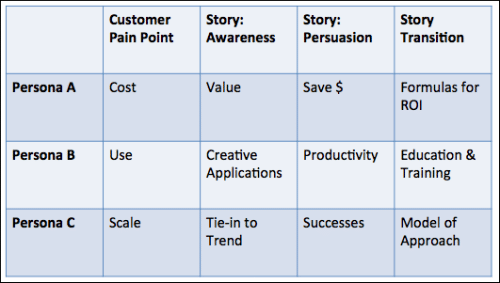
Key points and summary on creating marketing personas
- Gather data and progressively improve your marketing personas.
- Update them at least annually as part of your planning process.
- Quantify how many customers fit your persona regularly to understand changes. Customers can change and if you do not monitor these changes then you can lose to competitors.
- Work collaboratively in your marketing team to get a rounded view of each marketing persona.
- Try to minimize changes to the survey you use for your marketing persona to ensure you get a consistent view of the customer segments over time. This will help you identify changes.
- Regularly watch and talk to customers – not everything can be done from your desk!
FURTHER GUIDE – How To Create a Persona
TEMPLATE FOR PERSONA – THE PERSONA CANVAS

